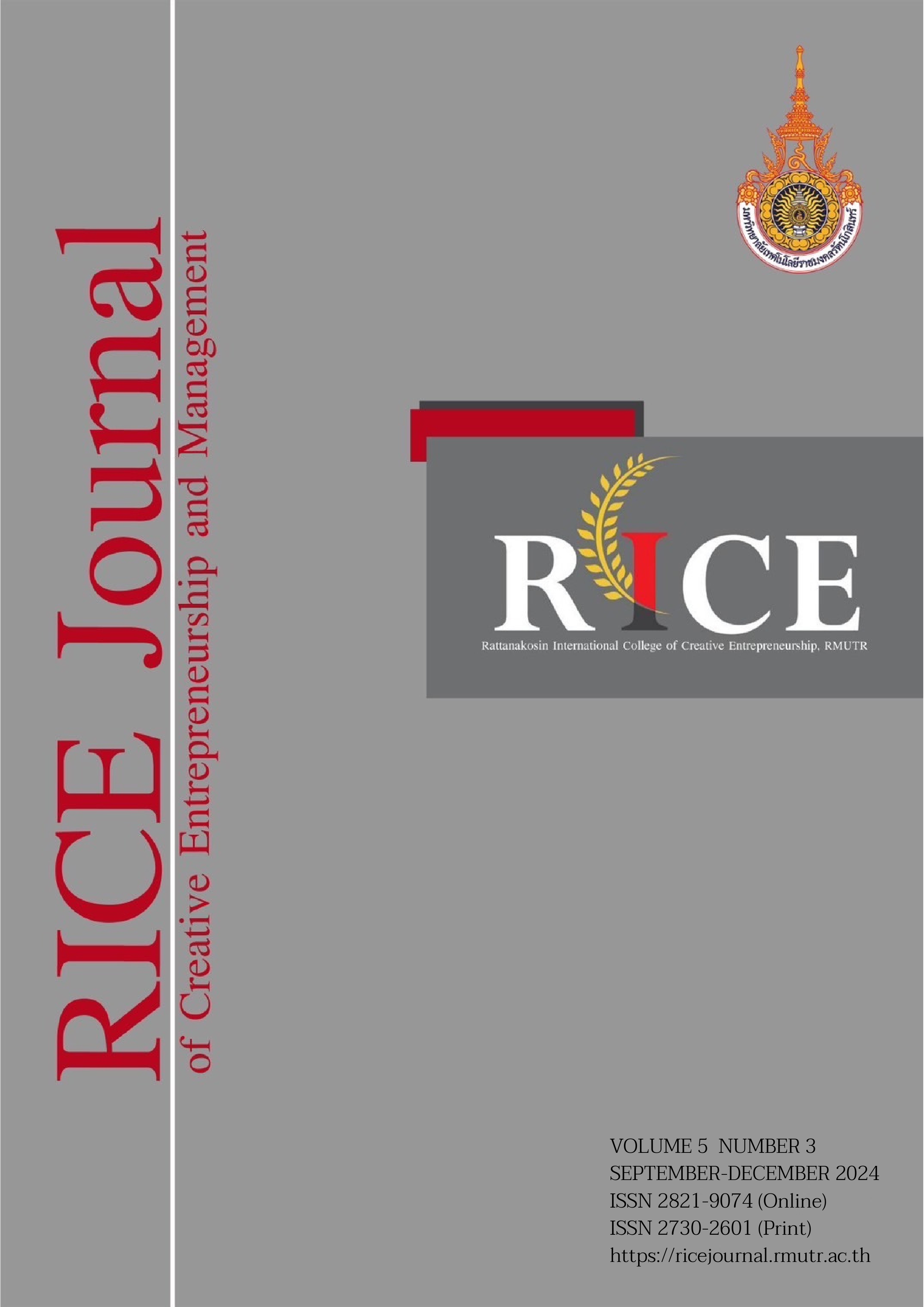The Market Value of Upcycled Home Decorative Furniture Products from Denim: A Case Study of Hiran Ruchi Subdistrict Community in Bangkok
Keywords:
Market value, upcycling process, home decorative furniture products, denim, Hiran Ruchi Subdistrict Community in BangkokAbstract
The problem of managing large waste, such as mattresses and sofas, is one of the major challenges in metropolitan areas, especially in Bangkok, where this type of waste is often disposed improperly and negatively impacts the environment. This research focuses on presenting a large-scale waste management approach through the upcycling process. One of the key materials explored in this research is denim, which is difficult to decompose but can be creatively reused. This research had three objectives: (1) To identify the initial problems regarding surplus materials in the community in Hiran Ruchi Subdistrict, Thon Buri District, Bangkok. (2) To develop a prototype of home decorative furniture products from denim through the upcycling process to create market value for the community. (3) To analyze the relationship between home decorative furniture products made from denim, and the upcycling process that creates market value for the community. The researchers collected data from 500 voluntary participants in the Hiran Ruchi community, using a survey questionnaire and a set of interview questions with IOC values greater than 0.6. The interviews with the participants focused on waste material problems in the community and selection of furniture for product development, and with professional experts on product design, production processes, and marketing. The results indicated the positive relationship between home decorative furniture products made from denim and the upcycling process that creates market value for the community. To the participants under study, the upcycling approach to product development not only addresses the identified waste problem but also taps on new markets for upcycled products with environmental sustainability value. It was also expected that upcycled products could help generate income for the community, aligning with the needs and value of modern consumers for environmental conservation and sustainability in product development.
References
Bocken, N. M. P., de Pauw, I., Bakker, C. & van der Grinten, B. (2016). Product design and business model strategies for a circular economy. Journal of Industrial and Production Engineering, 2016,33(5), 308-320.
Crilly, N., Moultrie, J. & Clarkson, P. J. (2004). Seeing things consumer response to the visual domain in product design. Design Studies, 2004, 25(6), 547-577.
Department of International Trade Promotion (DITP). (2022). DITP Research on Consumer Preferences: Sustainable Furniture Trends in Thai Consumer Markets. Bangkok: Ministry of Commerce, Thailand.
Ellen MacArthur Foundation. (2013). Towards the Circular Economy. The Isle of Wight, UK: Ellen MacArthur Foundation.
Foroudi, P. (2023). Design and consumer behavior: How aesthetics influence product evaluation. Journal of Consumer Behavior, 2023, 22(2), 167-184.
Kotler, P. (2016). Marketing Management. Fifteenth edition. London: Pearson Education.
Kotler, P. & Keller, K. L. (2016). Marketing Management. Fifteenth edition. London: Pearson Education.
Krungsri Research Center. (2022a). Eco-friendly furniture growth in Thailand. Market Trends and Consumer Behavior. Bangkok: Krungsri Bank.
Krungsri Research Center. (2022b). Market Insights into Green Furniture in Thailand. Bangkok: Krungsri Bank.
Krungsri Research Center. (2022c). Trends in Eco-Friendly Furniture in Thailand. Bangkok: Krungsri Bank.
Krungsri Research Center. (2022d). Upcycling and the Future of Sustainable Products in Thailand. Bangkok: Krungsri Bank.
Marx, K. (1867). Das Kapital Critique of Political Economy. Hamburg: Verlag von Otto Meissner.
Modernform. (2023). Eco-friendly furniture in the 'BCG' style. (Online). Digital information. https://modernform.co.th, July 11, 2023.
Noble, C. H. & Kumar, M. (2010). Exploring the relationships among product design, consumer involvement, and product quality. Journal of Product Innovation Management, 2010, 27(6), 967-982.
Pattamasiri, K. & Piyawong, P. (2023). Local product development and market expansion in Thai communities. Community Development Journal, 2023, 38(2), 123-140.
Pongsiri, N. & Thongmak, M. (2020). Design and consumer perception in OTOP products. Journal of Marketing Research, 2020, 57(4), 355-370.
Programme for the Endorsement of Forest Certification (PEFC). (2022). Sustainable Furniture Research: Sustainable Furniture and Consumer Preferences. Geneva, Switzerland: PEFC International.
Qiao, Y., Shi, X. & Chen, J. (2022). Branding and product value creation through design. Journal of Product and Brand Management, 2022, 31(3), 252-267.
Ricardo, D. (1817). On the Principles of Political Economy and Taxation. Hachette, UK: John Murray Publishers.
Smith, A. (1776). An Inquiry into the Nature and Causes of the Wealth of Nations. London: W. Strahan and T. Cadell Publisher.
Somsri, R. (2019). Product Design from Natural Materials and Upcycling in Community Crafts. Bangkok: Kasetsart University Press.
Stahel, W. R. (1976). The Potential for Substituting Manpower for Energy Report to the European Commission. Luxembourg: European Commission.
Suansri, N. (2022). Strategies for Increasing the Value of Products from Textile Waste in Rural Communities. Bangkok: Thammasat University Press.
Tsiotsou, R. H. (2016). The role of perceived product quality and overall satisfaction on purchase intentions. Journal of Retailing and Consumer Services, 2016, 29, 74-82.
Ulrich, K. T. & Eppinger, S. D. (2012). Product Design and Development. Fifth edition. New York: McGraw-Hill.
Xu, Y., Hong, P., & Zhang, J. (2022). Cultural creative product design and consumer perception A study of value creation. International Journal of Market Research, 2022, 64(1), 3-21.
Downloads
Published
How to Cite
Issue
Section
License
Copyright (c) 2024 RICE Journal of Creative Entrepreneurship and Management

This work is licensed under a Creative Commons Attribution-NonCommercial-NoDerivatives 4.0 International License.

